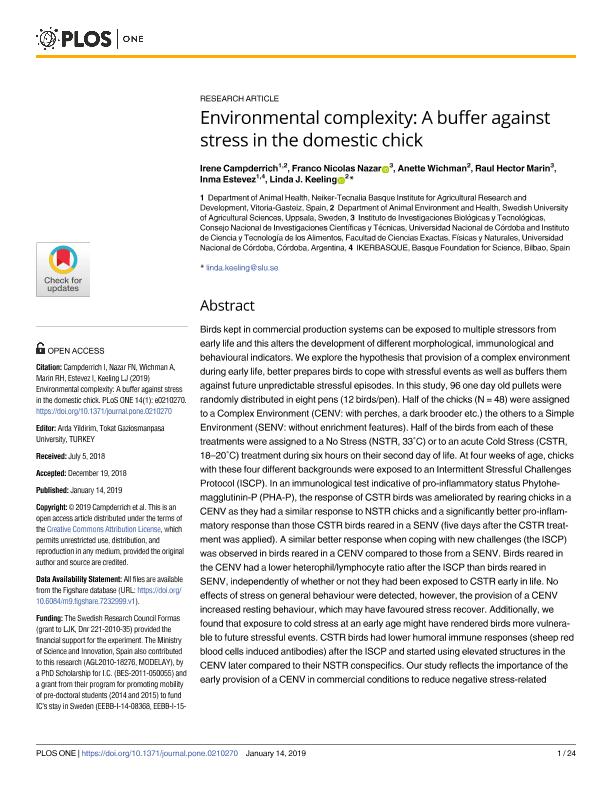Mostrar el registro sencillo del ítem
dc.contributor.author
Campderrich, Irene
dc.contributor.author
Nazar, Franco Nicolas

dc.contributor.author
Wichman, Anette
dc.contributor.author
Marin, Raul Hector

dc.contributor.author
Estevez, Inma
dc.contributor.author
Keeling, Linda J.
dc.date.available
2020-02-05T16:56:40Z
dc.date.issued
2019-01
dc.identifier.citation
Campderrich, Irene; Nazar, Franco Nicolas; Wichman, Anette; Marin, Raul Hector; Estevez, Inma; et al.; Environmental complexity: A buffer against stress in the domestic chick; Public Library of Science; Plos One; 14; 1; 1-2019
dc.identifier.uri
http://hdl.handle.net/11336/96740
dc.description.abstract
Birds kept in commercial production systems can be exposed to multiple stressors from early life and this alters the development of different morphological, immunological and behavioural indicators. We explore the hypothesis that provision of a complex environment during early life, better prepares birds to cope with stressful events as well as buffers them against future unpredictable stressful episodes. In this study, 96 one day old pullets were randomly distributed in eight pens (12 birds/pen). Half of the chicks (N = 48) were assigned to a Complex Environment (CENV: with perches, a dark brooder etc.) the others to a Simple Environment (SENV: without enrichment features). Half of the birds from each of these treatments were assigned to a No Stress (NSTR, 33C) or to an acute Cold Stress (CSTR, 18–20C) treatment during six hours on their second day of life. At four weeks of age, chicks with these four different backgrounds were exposed to an Intermittent Stressful Challenges Protocol (ISCP). In an immunological test indicative of pro-inflammatory status Phytohe-magglutinin-P (PHA-P), the response of CSTR birds was ameliorated by rearing chicks in a CENV as they had a similar response to NSTR chicks and a significantly better pro-inflammatory response than those CSTR birds reared in a SENV (five days after the CSTR treatment was applied). A similar better response when coping with new challenges (the ISCP) was observed in birds reared in a CENV compared to those from a SENV. Birds reared in the CENV had a lower heterophil/lymphocyte ratio after the ISCP than birds reared in SENV, independently of whether or not they had been exposed to CSTR early in life. No effects of stress on general behaviour were detected, however, the provision of a CENV increased resting behaviour, which may have favoured stress recover. Additionally, we found that exposure to cold stress at an early age might have rendered birds more vulnerable to future stressful events. CSTR birds had lower humoral immune responses (sheep red blood cells induced antibodies) after the ISCP and started using elevated structures in the CENV later compared to their NSTR conspecifics. Our study reflects the importance of the early provision of a CENV in commercial conditions to reduce negative stress-related effects. Within the context of the theory of adaptive plasticity, our results suggest that the early experience of the birds had long lasting effects on the modulation of their phenotypes.
dc.format
application/pdf
dc.language.iso
eng
dc.publisher
Public Library of Science

dc.rights
info:eu-repo/semantics/openAccess
dc.rights.uri
https://creativecommons.org/licenses/by-nc-sa/2.5/ar/
dc.subject
STRESS
dc.subject
DOMESTIC CHICKS
dc.subject
COLD
dc.subject
IMMUNE SYSTEM
dc.subject.classification
Otras Ciencias Veterinarias

dc.subject.classification
Ciencias Veterinarias

dc.subject.classification
CIENCIAS AGRÍCOLAS

dc.title
Environmental complexity: A buffer against stress in the domestic chick
dc.type
info:eu-repo/semantics/article
dc.type
info:ar-repo/semantics/artículo
dc.type
info:eu-repo/semantics/publishedVersion
dc.date.updated
2020-01-13T14:42:17Z
dc.identifier.eissn
1932-6203
dc.journal.volume
14
dc.journal.number
1
dc.journal.pais
Estados Unidos

dc.journal.ciudad
San Francisco
dc.description.fil
Fil: Campderrich, Irene. Centro de Investigación. Neiker - Tecnalia; España. Swedish University of Agricultural Sciences; Suecia
dc.description.fil
Fil: Nazar, Franco Nicolas. Universidad Nacional de Córdoba. Facultad de Ciencias Exactas Físicas y Naturales. Instituto de Ciencias y Tecnología de los Alimentos; Argentina. Consejo Nacional de Investigaciones Científicas y Técnicas. Centro Científico Tecnológico Conicet - Córdoba. Instituto de Investigaciones Biológicas y Tecnológicas. Universidad Nacional de Córdoba. Facultad de Ciencias Exactas, Físicas y Naturales. Instituto de Investigaciones Biológicas y Tecnológicas; Argentina
dc.description.fil
Fil: Wichman, Anette. Swedish University of Agricultural Sciences; Suecia
dc.description.fil
Fil: Marin, Raul Hector. Universidad Nacional de Córdoba. Facultad de Ciencias Exactas Físicas y Naturales. Instituto de Ciencias y Tecnología de los Alimentos; Argentina. Consejo Nacional de Investigaciones Científicas y Técnicas. Centro Científico Tecnológico Conicet - Córdoba. Instituto de Investigaciones Biológicas y Tecnológicas. Universidad Nacional de Córdoba. Facultad de Ciencias Exactas, Físicas y Naturales. Instituto de Investigaciones Biológicas y Tecnológicas; Argentina
dc.description.fil
Fil: Estevez, Inma. Centro de Investigación. Neiker - Tecnalia; España
dc.description.fil
Fil: Keeling, Linda J.. Swedish University of Agricultural Sciences; Suecia
dc.journal.title
Plos One

dc.relation.alternativeid
info:eu-repo/semantics/altIdentifier/doi/http://dx.doi.org/10.1371/journal.pone.0210270
dc.relation.alternativeid
info:eu-repo/semantics/altIdentifier/url/https://journals.plos.org/plosone/article?id=10.1371/journal.pone.0210270
Archivos asociados
